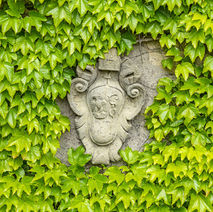
THE VILLAGE
To the rhythm of history
Querceto from the start produces two strong emotions: that of travelling through history and that of being immersed in nature. As you drive along the lovely road climbing up the hill your gaze gets lost in endless sweet green views until finally, way up on top, you catch a first glimpse of the outline of the village and the castle standing out clearly against the blue sky.
Entering Querceto, on foot as in ancient times, is a transformative experience involving all of the senses: time changes its rhythm, smells become more intense, thoughts and voices of people mingle between the Locanda, which is always open, and the bumbling noise of the little van which comes up once a week to offer its wares to the inhabitants of the village…. Here every breath speaks of a place where time has never stopped.
Querceto is more alive than any other place: words take on profound intense meaning, tradition makes itself felt, nature and the countryside flow slow and strong, the eyes of all creatures greet the setting of the splendid sun that floods Querceto every day.
CASTELLO GINORI DI QUERCETO
To the rhythm of history
Castello Ginori of Querceto is an ancient village, near Volterra, on the slopes of Mount Aneo in the center of a large estate.
The origin of the village goes back to 1000 a.c., when it belonged to the church of Massa Marittima.
Towards the end of 1100 the bishop of Massa Marittima transferred his rights to the Abbot of Monteverdi.
In 1208 Querceto, together with the other castles of the Val di Cecina, was yielded to the town of Volterra. In those days Querceto was very important for its strategic position and for its many natural resources, first of all the salted water springs. In its subsoil minerals could be found, such as silver, copper, mercury and vitriol, all items much sought after on the international markets in the Middle Age.
After two centuries in which many armed skirmishes and revolts took place in and around Volterra, in 1430 the castle was occupied and pillaged by the troops of Giangaleazzo Visconti, Duke of Milan.
In 1447 Querceto was conquered by the troops of Alfonso d’Aragona King of Naples in war against Florence.
The 16th century was marked by the Florentine domination, because after the conquest of Volterra the inhabitants of Querceto had to swear fealty to the “Signoria” of Florence. It was during this period, around 1543, that the noble family Lisci of Volterra got involved with Querceto.
In 1786 the last Lisci’s descendant, Francesca, married Marchese Lorenzo Ginori. After years of famine and poverty during the government of the Medici dynasty, the Querceto conditions much improved, thanks to the Ginori’s administration
In 1814 Carlo Leopoldo inherited from his mother Francesca the estate and her family name “Lisci”; from then onwards the castle and the estate belong to the family. He made many modern reforms in the methods of cultivation and was especially interested in cattle breeding. In 1834 he built the bridge on the river Cecina near the village of Ponte Ginori that connected the estate with the public road of the Val di Cecina.
In the 20th century with Lorenzo and his son Leonardo the farming of the land was much promoted and the estate became a model of agricultural enterprise.
In these days the village is completely restored and typical rustic style but comfortable holiday apartments have been made.






















